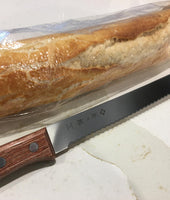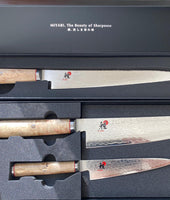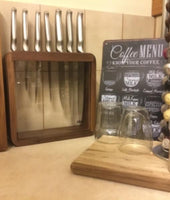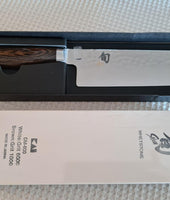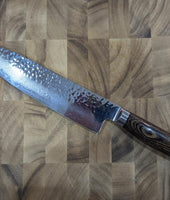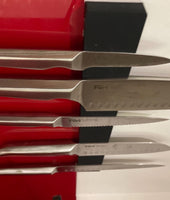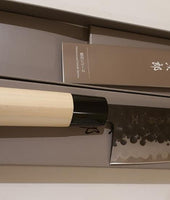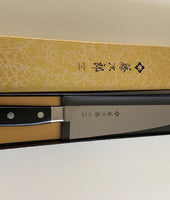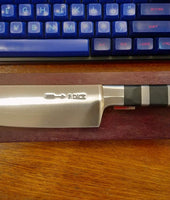
One of the very crucial aspects of caring for your knives is sharpening them. It is the only way you ensure the blades that have lost their edge stay sharp and prevent them from becoming dull, which often leads to accidents and poor work. Whetstones are one of the best tools in this role.
Steel tools such as Japanese kitchen knives and scissors can be sharpened with a sharpening stone.
Although whetstone is often misconstrued to indicate stones being lubricated by water, the term is based on the word ‘whet’ which means to sharpen a blade.
Whetstones come in a wide selection of different sizes, shapes and types of materials.
What is Grit?
The burning question for those new to using a whetstone is…what does the digit on the side of the whetstone indicate?
Without knowing this, you could be wasting your time trying to sharpen your kitchen knives with a whetstone too smooth, or even worse, damaging your cooking tools in the process.
The digit or ‘grit’ size which comes labeled with every whetstone refers to the grit size of the abrasive particles in the stone. This is given as a number, as it indicates the spatial density of the particles.
A lower number for examples denotes a lower density ie. larger particles more spaced apart giving it a rougher surface, leading to a more thorough and aggressive sharpen for dull or even possibly damaged blades.
There are 4 main stages or brackets of grit, and each one is categorised to sharpen your knife differently. We will explore each of these categories below to help you understand how each bracket is different, and how you can select the right whetstone grit when sharpening or polishing your kitchen knives.
Coarse Whetstones: #1000 or less
If you have any kitchen knives which are damaged, has any nicks or chips in the blade or is extremely dull, then you should be looking to a grit size of #1000 or less. A whetstone of this grit will smooth out any kinks in your blade in no time assuming the knife can still be salvaged.
If your knife is dull and has completely lost its edge, then these whetstones are for you.
A word of caution: due to their abrasiveness, these whetstones shouldn’t be used for general sharpening as they don’t leave the best finish on your blade edge. Due to the low grit, they may damage a knife when too much pressure is applied. And a low grit means that a lot of material is being taken off the knife so choosing the right level of grit is imperative for keeping your Japanese knives in tip-top condition.
Shop our range of whetstones to repair blunt or chipped knives
Medium Stones: #1000 - #3000
The #1000 grit whetstone is your go-to sharpening stone. If your Japanese knives need a good sharpen to regain their edge, then this grit is your starting point. But use this sparingly as it will wear your knife down. Whetstones in the #2000-3000 range are less coarse and are more appropriate for the individual who like to sharpen their Japanese knives more regularly. But keep in mind, this range is still focused on ‘sharpening’ your knives, and not maintaining the blade’s edge.
Medium grit stones are fantastic at giving your Japanese knives that razor out-of-the-box sharpness.
Shop our range of whetstones to maintain a sharp edge on your knives
Finishing Stones: #4000 - #8000
For those looking teetering on the cusp between wanting to sharpen and achieve a superfine edge, then #4000 - #5000 range is best suited for you.
Some may see this range as far as they need to go as a ‘finisher’ for their knives. This would apply in particular if you are using a Western knife which typically has a ‘U’ rather than a ‘V’ shaped edge, and a #5000 grit whetstone may be as far as you need to go.
As a guide, if you are cutting meat then it may be in your best interests to stop at #4000 - #6000 grit. The reason for this is #8000 grit and above whetstones may leave your knife exposed to bending whilst cutting through muscle and sinew.
If you are only using your Japanese knives for cutting fruits and vegetables, feel free to go all the way up to a #8000 grit whetstone.

Shop our range of whetstones for finishing or honing your blades
What to Consider When choosing a Whetstone
There are plenty of whetstones on the market, and it may be challenging to find the best for your kitchen knives. It is also essential to know what serves your circumstances, and the type of knives will determine which whetstone best suits you. Here are the various factors to consider when choosing the best whetstone for your knives and other cutting tools.
Size
The right whetstone should have the correct width and length to fit your cutting tools. A small whetstone will not work with bigger knives and make the sharpening process unsafe, and it is frustrating trying to cover the length of the whole blade. For kitchen knives, the size should be around 6 to 8 inches long.
Value for money
To get the best value for money, you should consider the product's durability, the quality you are getting, and the price. The best whetstone will give you more for your buck. Depending on the material, look at the quality and other aspects like double-sided stones with different grits on each side.
Guide to Whetstone Sharpening
In Summary

How to take care of your sharpening stones
Before use:
Do not soak in water finishing stones #3000 and above. If needed splash with water only.
After use:
Let the stone dry thoroughly. Returning a stone into its box while still wet or damp will result in molding and affect its quality over time.
Key Notes and Summary
Sharpening vs Honing
- Sharpening fixes any chips and wear on the blade by removing small amounts of metal from the edge of the blade to return its sharp edge. Depending on how often the knife is used, you should only need to sharpen once ever few weeks or less.
- Honing on the other hand, realigns the blade to ensure you are cutting with a straight edge and should be done ideally once a week or more to extend the longevity of your knives.
Whetstones
- Is the best way to sharpen a knife, a whetstone acts like sand allowing more blade movement and sheds the least amount of metal.
- Respects the shape of the blade, important for Japanese knives which have a tapered V-shaped edge. Whetstones which are freestanding allow you to use both hands to press the blade against the stone to determine the exact angle.
- Keeps your knife in top condition, and ensure it lasts for the longest possible time.
- Using a whetstone is a process. You’ll need to soak it in water for 10 minutes, then sharpen both sides (unless it is a single bevel), and then honing both sides of the blade can take 30 minutes.
Choosing the right whetstone
- Whetstones have been developed to cater for the needs of enthusiastic cooks to professional chefs and are available in a wide range of abrasive grades:
- Coarse (#220-#400) for repairing chips and reshaping the blade
- Medium (#800-#1000) for regular edge maintenance
- Fine (#3000-#8000) for polishing and honing to a razor finish
Where to find the best whetstones
It is hard to find one marketplace that specializes in all the quality whetstones. That is why House of Knives exists to fill that gap. We bring together all the best products from the top manufacturers globally in one place.
You can pick the best whetstone from various brands at a competitive price. We also provide a seamless shopping experience and access to plenty more quality knives and knife accessories.
Shop our range of premium whestones today.
Also Read: Best Japanese in Adelaide: Strategies and Tactical Principles for Success



























